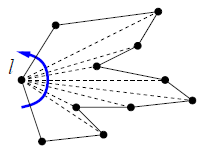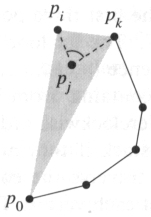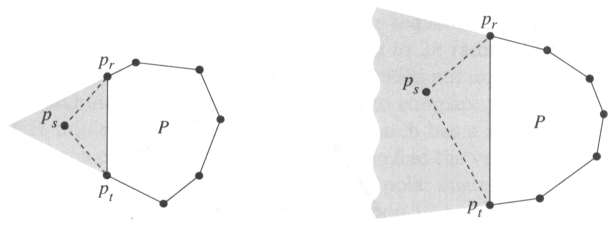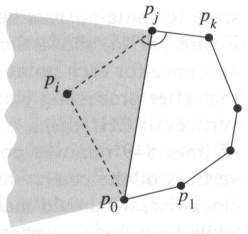![]()
![]()
The first paper published in the field of computational geometry was on the construction of convex hull on the plane. And the honor goes to Graham. In the late 1960s, the best algorithm for convex hull was O(n2). At Bell Laboratories, they required the convex hull for about 10,000 points and they found out this O(n2) was too slow. In 1972, R. L. Graham developed his simple and efficient algorithm in response to this need. The algorithm is efficient in the sense that no matter how many points are on the boundary of the convex, it runs efficiently. Historically, this is the first publication that showed convex hull computation in O(n lg n) time in the worst case. In 1981, A. C. Yao proved that it is optimal in the worst-case sense. Note that O'Rouke reported that Toussaint (1985) found an earlier paper by Bass & Schubert (1967) that contained many ideas that appeared in later hull algorithms. The problem with Graham's algorithm is that it has no obvious extension to three dimensions. The reason is that the Grahams scan depends on angular sorting, which has no direct counterpart in three dimensions.
Overall Strategy
The Graham's algorithm first explicitly sorts the points in O(n lg n) and then applies a linear-time scanning algorithm to finish building the hull. The Graham's scan algorithm for computing the convex hull, CH, of a set Q of n points in the plane consists of the following three phases:
Phase I. First, select a anchor point (base point) p0 in Q, normally this is the point with minimum y-coordinate. In case of the tie, we select leftmost point (minimum x-coordinate) in the set.
Phase II. Next, sort the remaining points of Q (that is, Q − {p0}) lexicographically by polar angle, measured in radians. Interior points on the ray cannot be a convex hull points and remove these points during sort. Once the points are sorted, we connected them in counterclockwise order with respect to the anchor point p0. The result is a simple polygon as in figure below. Note that no explicit computation of angles is performed by the algorithm.

Note that a simple polygon formed in the sorting phase of Graham's scan.
Phase III. After pushing the anchor point p0 onto the stack S, we scan through the points in counterclockwise order, maintaining at each step a stack S containing a convex chain surrounding the points scanned so far. Each time we consider the new point pi, we perform the following test:
a. If pi forms a left turn with the last two points in the stack S, or if S contains fewer than two points, then push pi onto the stack S.
b. Otherwise, pop the last point from the stack S and repeat the test for pi.
We halt when we return to the anchor point p0, at which point stack S stores the vertices of the convex hull of Q in counterclockwise order.
Formal Algorithm
The details of the scan phase (Phase 3) are formalized in the following algorithm: [For the sake of completeness, we are including the other two phases too.]
GRAHAM_SCAN(Q)
1. Find p0 in Q with minimum y-coordinate (and minimum
x-coordinate if there are ties).
2. Sorted the remaining points of Q (that is, Q
− {p0}) by polar
angle in counterclockwise order with respect to p0.
3. TOP [S] = 0
▷ Lines 3-6 initialize the stack to contain, from bottom to top, first three
points.
4. PUSH (p0, S)
5. PUSH (p1, S)
6. PUSH (p2, S)
7. for i = 3
to m
▷ Perform test for each point p3, ..., pm.
8. do
while the angle between NEXT_TO_TOP[S], TOP[S], and pi
makes a nonleft turn ▷ remove if not a vertex
9.
do POP(S)
10. PUSH (S, pi)
11. return S
Running Time Computation
Line 1 requires O(n) time to find the anchor point po (i.e., point with minimum y-coordinate). Since sorting based on polar angle takes O(n lg n) time, Line 2 requires O(n lg n) time (using merge or heap sort to sort polar angles). Moreover, removal of n − m points with duplicate angles takes O(n) time. Lines 3, 4, 5, and 6 require constant time, O(1), to initialize the stack to contain the first three points. For-loop in Line 7 is executed m − 2 times, so it takes O(n) time.
Now the while-loop in Line 8. This is a "problem". It may iterate as many as O(n) time, which leads to an over-estimate of O(n2). Note that each pass through the while statement, POP is executed.
We use the aggregate method of amortized analysis to analyze the while-loop. As in analysis of MULTIPOP, we observe there is at most one pop for each push operation. In case of GRAHMS SCAN, at least three points (p0, p1 and pm) are never popped from the stack. So in fact, at most m − 2 pop operations are performed. Therefore, the amortized cost of each Iteration of while loop is O(n)/n = O(1). It implies that the overall worst-case for for-loop is O(n). The worst case running time of GRAHAM_SCAN is
T(n) = O(n) + O(n lg n) + O(1) + O(n) = O(n lg n), where n = |Q|.
Correctness of Grahams Scan
The correctness of Graham scan lies in two situations.
Part 1 deals with nonleft turns.
Part 2 deals with left turns.
Claim 1: Each point popped from the stack is not a vertex of CH(Q) and lies inside new CH(S).

Proof of Claim 1
Suppose that point pj is popped from the stack because angle pk pj pi makes a nonleft turn as shown in the above figure. Since points are ordered in increasing polar angle around anchor p0, there exists a triangle ∆ p0 pi pk with pj either in the interior of the triangle or on the line segment joining pi and pk (geometric property). In either case, point pj cannot be a vertex of CH(Q). And this completes the proof of claim 1.
Claim 2 The points on stack always form the vertices of a convex polygon.
Proof of Claim 2 The claim holds immediately after line 6, since points p0, p1, and p2 form a convex polygon (i.e. a triangle). Now examine how stack changes during the course of the algorithm. Stack changes in two ways:
Case i: When points are popped onto the stack S.
Case ii. When points are pushed onto the stack S.
Case i. Here we rely on the following geometric property:
If a vertex is removed from a convex polygon, then the resulting polygon is convex.
Case ii. To analyze this case, we rely on the following geometric property:

If we add point ps in the shaded regions to polygon P, then the resulting polygon is convex.
Now back to the case ii. Consider a point pi that is pushed onto the stack S. Keeping the above geometric property in mind, we claim the following:
Subclaim If a point pi is pushed onto the stack, the resulting points form a convex polygon.

Proof of Subclaim Suppose pj be the vertex on the top of the stack and also pk be the predecessor of pj on the stack.
By the choice of p0 and p1, pi lies above the extension of the line p0 p1. As a result, pi lies on the shaded region.
By the fact, a left turn occurs at pj, pi lies below the extension of the line joining pk and pj. As a result pi lies on the shaded region.
By the fact, pi occurs later in the sequence than pj, the polar angle of p0pi is greater than polar angle of p0pj thus pi of lies left of the line joining points p0 and pj. As a result pi lies in the shaded region.
So, the above three propositions imply that pi is in the
shaded region. (And we know this corresponds directly to the shaded region of
our geometric property.) Therefore, after pi has been pushed onto the stack, the
points on stack form a convex polygon. And this completes the proof.
Conclusion
Since each point popped from the stack is not a vertex of CH(Q) ( by claim 1). And the points on stack always form the vertices of a convex polygon (by claim 2). Therefore, Grahams scan is correct.
Applet
Graham's scan starts with 25 random points, and then computes their convex hull.
The algorithm works in three phases (as mentioned above):
Find an extreme point. This point will be the anchor. The anchor is guaranteed to be on the hull, and is chosen to be the point with smallest y coordinate.
Sort the points in order of increasing angle around the anchor. We end up with a star-shaped polygon. Note that the anchor can "see" the whole polygon.
Build the hull, by marching around the star-shaped polygon, adding edges when we make a left turn, and back-tracking when we make a right turn.
![]()
Updated: May 1, 2010.